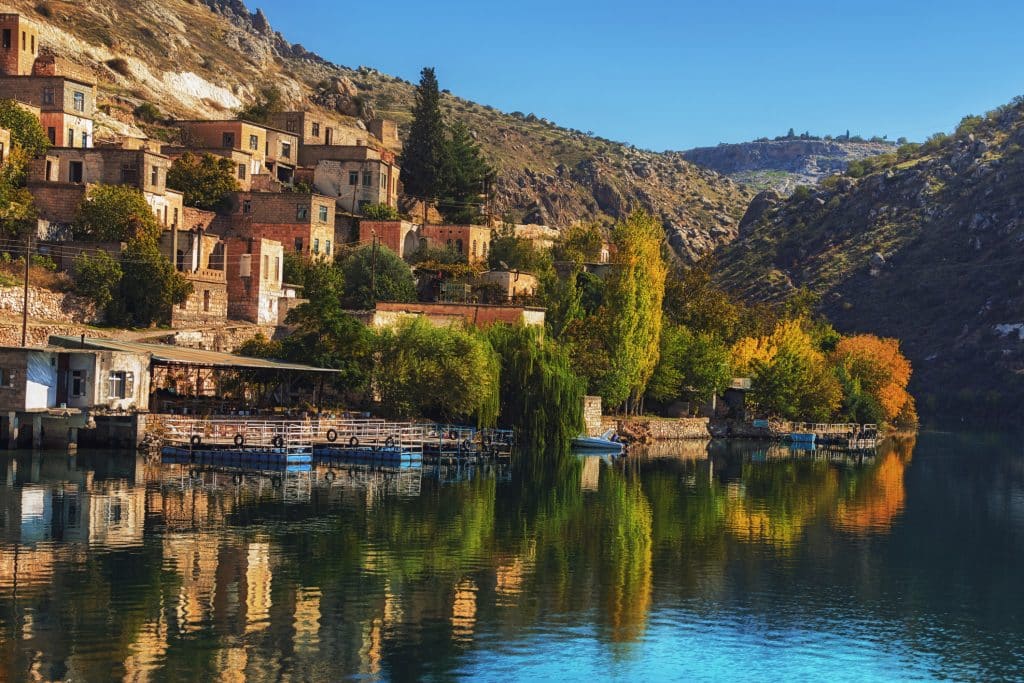Sunken city: Halfeti

Located in western Şanlıurfa, Halfeti is a quiet, charming town. About half of the city was flooded during the construction of the Birecik Dam in 2000, and local residents were settled about 15 kilometers away. Lapped by the waters of the Euphrates River, the submerged village offers a glimpse of timelessness, with ancient stone houses, mosques and trees, some of which appear to be rising out of the water. The underwater village can be visited by boat.
As a place where history lives, the ancient city of Halfeti was founded in the 9th century B.C. by the Assyrian king Salmanassar III and later hosted the Hittite, Persian, Macedonian and Seleucid civilizations. The historical richness of Halfeti also bears traces of the Abbasid, Umayyad, Seljuk, Zengi and Ayyubid cultures.
In 2013, Halfeti was included in the Slow City network by the Cittaslow International Coordination Committee and, more recently, it has attracted attention with developments in the tourism field. Now visited by approximately 650,000 tourists each year, Halfeti is a special destination for an autumn holiday.
How to get to Halfeti

With a population of 40,000 people, Halfeti is a small district in Şanlıurfa. It is 110 kilometers from Şanlıurfa town and about 105 kilometers from Gaziantep; both the Şanlıurfa and Gaziantep airports are convenient to Halfeti. Many visitors opt to arrive in Şanlıurfa, which features a number of historical sites, including Balıklıgöl (the Pool of Abraham), the Şanlıurfa Archaeology Museum, the Mevlid-i Halilurrahman Cave, Urfa Castle, the Rizvaniye Mosque and the Haleplibahçe Mosaic Museum. If time allows, the spectacular archaeological site of Göbeklitepe is just 20 kilometers from the Şanlıurfa center. For more information on Göbeklitepe and its 12,000-year-old temple, please see 5 Questions about Göbeklitepe.
Halfeti is accessible via private vehicle or by minibuses departing from the Şanlıurfa and Gaziantep Bus Terminals.
An out-of-this-world experience: Halfeti boat tour

A visit to Halfeti is particularly special in the autumn, with the season bringing an almost magical atmosphere to the sunken city. A boat tour is the best way to experience this setting. Among the different routes through Şanlıurfa and Gaziantep, we recommend the Çekem District, Savaşan Village and Rumkale route over the Euphrates River. Bring a camera to take pictures of the submerged mosque, with its minaret rising out of the water, and Old Halfeti, the St. Nerses Church, the Barşavma Monastery and the cisterns, wells and underwater houses and trees.
Many companies offer daily boat tours. Private boat tours are also available.
An even better view of a sunken city: Diving at Halfeti

With a village beneath the waters of the Euphrates River, the sunken city of Halfeti is a candidate for one of the world’s most interesting dives. Under the water, divers can view historical artifacts of the region, including the Halfeti Grand Mosque, Hamamlı Konak, Kiyi Mansions, Savaşan Village and Mosque, and the Armenian Church.
One of a kind: The Black Rose of Halfeti

While not actually pitch-black, this enchanting rose features a distinctive fragrance and a dark, deep crimson color with a velvety black sheen. When seeds of the black rose are planted elsewhere, the buds are black, but the roses grow a dark crimson. It only grows only in Halfeti, and the reason for this is the area’s unique microclimate.
According to local legend, Vartuhi, the beautiful daughter of Asadur, an Armenian stone master working on the construction of the Grand Mosque, grew red roses in her garden. On the other side of the river, there lived a young Muslim man who raised pigeons. One day a young pigeon flew into Vartuhi’s garden and the young man, attempting to retrieve his bird, saw Vartuhi and immediately fell in love. Their families were opposed to the marriage and, thus, the distraught couple committed suicide by leaping into the waters of the Euphrates. Mourning for the young lovers, the roses in Vartuhi’s garden turned black.
Also known as the Hyacinth of Mesopotamia, The Lord of the Roses, The Weeping Arabian Girl, the Arabian Bride and the Arab Beauty, the black rose blooms in the spring and autumn. A stroll in the black rose gardens is particularly lovely in the fall season.
The black rose of Halfeti will last for quite a long time if provided with the proper care. If you visit Halfeti for the autumn holiday, you may want to bring home one of these gorgeous flowers.
Dining in Halfeti

Halfeti’s enchanting beauty and rich history are reflected in its diverse cuisine. Shabut fish kebab, poppy kebab, onion kebab, cağırtlak kebab, tomato kebab and eggplant kebab are just some of the town specialties, along with dolma eziği, rice with black chickpeas, tarhana soup, panned plums and semsek. For dessert, the rice pudding, wrapped Burma dessert and cheese halva are famous.
If you wish to bring home a taste of Halfeti, consider homemade pomegranate syrup, peppers, zucchini, dried eggplant and dried okra, as well as isot pepper, thyme juice, raisins and peanuts.
Stories knock at your door!
You can easily download images, and share on your social media accounts via your smartphone. Just press and hold the story, and save or share the image you have selected via the menu that appears.




